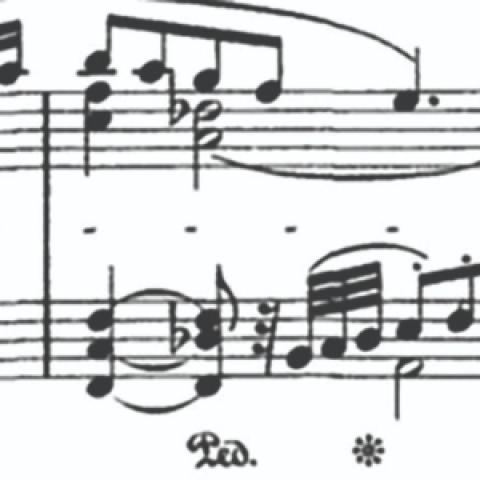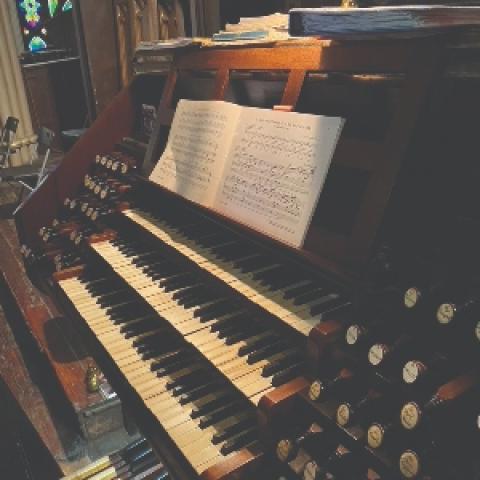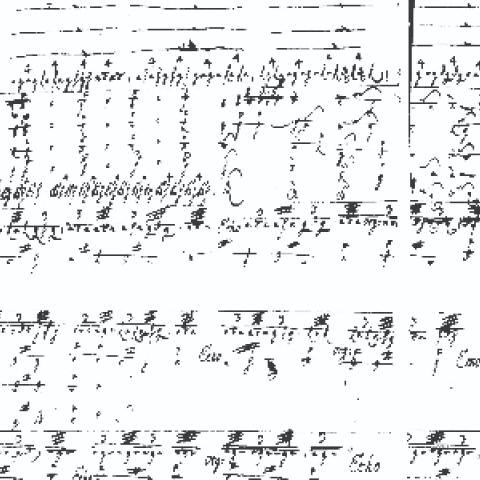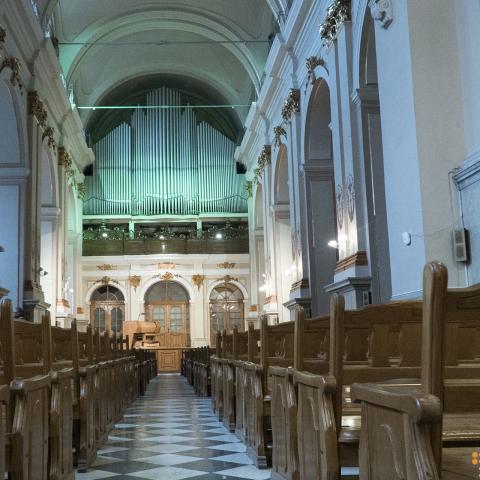Warren R. Johnson, a retired organist-choirmaster, is a freelance writer living in Boquete, Panamá. Some of his works can be seen in part at www.clippings.me/warren-r-johnson. He also publishes the blog www.TravelSketches.info.
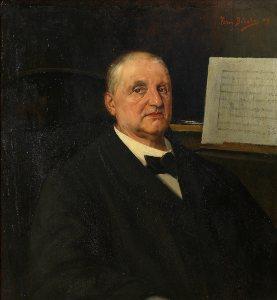
It is one thing to love a pipe organ, but to be buried under one is another thing. Yet that is exactly what Josef Anton Bruckner did. He designed his own sarcophagus and had himself placed under his favorite organ in Saint Florian Monastery in Austria.
Like Johann Sebastian Bach, Bruckner was an organist, though he composed no significant organ works. Unlike Bach, he traveled outside central Europe, concertizing in England and France. Bruckner did eventually achieve fame with his symphonies and choral works allowing him to (unofficially) become the fourth “B” after Bach, Beethoven, and Brahms.
Bruckner was born into a musical family in the farming community of Ansfelden, Austria, the oldest of eleven children. His father was an organist, and his mother sang in a choir. He received his initial schooling in Ansfelden and then progressed to Hörseling for more education, studying organ with Johann Baptist Weiss, his cousin and godfather. Weiss was an impetus for Bruckner becoming a fine organist. Bruckner was as serious about the organ as he was later about composing, often practicing as long as twelve hours a day.1
When Bruckner was thirteen, his father died. With eleven children in the family, Anton’s mother could not support all of them. Consequently, he was sent to the Augustinian monastery in Saint Florian. There he sang in the boy choir while also studying violin and organ. Saint Florian Monastery possessed two organs; the larger one was known as the “Chrismann Organ.” This organ was originally built in the Baroque style between 1770 and 1774 and was rebuilt the year Bruckner arrived at the monastery. It was expanded to four manuals, seventy-eight registers by Mathias Mauracher of Salzburg2 and was the second largest organ in Austria at the time.3 Bruckner was able to occasionally play services on this instrument. The organ later came to be called the Bruckner organ.
Bruckner needed to earn a living, so he left the monastery in 1841 to become a school teacher. His mother arranged for him to attend a teaching seminar in Linz that year, returning to the monastery in 1845 as a teacher and one of the organists. He passed a teaching examination that year so that he could work as a teacher’s assistant. He continued taking teaching courses earning a good grade that allowed him to teach upper-level courses. In 1851, he became the official organist of the monastery and served until 1855.
He left Saint Florian fearing a limit to his musical growth if he remained there, and, at the urging of friends, he applied for the position of organist at the cathedral of Linz. He won this position and remained there for twelve years. During his first three years in Linz, Bruckner began studying composition with Simon Sechter of Vienna. He did this from Linz by correspondence and six-week visits yearly.4 Working with Sechter, himself an organist, resulted in profound growth in his compositional skills.
He left Linz so that he might take the position of instructor at the Vienna Conservatory replacing Sechter, teaching both composition and organ. He remained there for twenty-four years, with such students as Hans Rott and Franz Schmidt, the former who influenced Gustav Mahler. Mahler was also a student at the conservatory and may even have studied with Bruckner. In 1875, Bruckner was appointed lecturer of harmony and counterpoint at the University of Vienna and was later awarded an honorary Doctor of Philosophy degree there.
While in Vienna, Bruckner also held the position of organist of the Imperial Court chapel (1868–1892).5 By then, he had established an international reputation and began a concert career. At the invitation of organbuilder Merklin-Schütze, he played an organ recital in France at Saint Epvre, Nancy, in 1869. This was quickly followed by recitals at Notre Dame Cathedral, Paris, in 1870 and in England in 1871, where he gave six recitals at Royal Albert Hall on the new Willis organ and five more at the Crystal Palace.6
Much of Bruckner’s organ playing was improvisational; consequently, no transcriptions are available. There are nine organ compositions attributed to him. It is likely, however, that he composed only six of these works:7
• WAB 127, Prelude in E-Flat Major (c. 1836)
• WAB 128, Four Preludes for Organ (c. 1836)
These two works and possibly WAB 126 are likely not by Bruckner.8
• WAB 126/1, Prelude in D Minor (c. 1847)
• WAB 126/2, Postlude in D Minor (c. 1847) (Manuscript stored in the archives of Saint Florian Monastery)
• WAB 130, Prelude in D Minor (c. 1847)
• WAB 131, Vorspiel und Fugue (1847) (The incomplete score was completed by Franz Phillip in 1929.)
• WAB 125, Fugue in D Minor (1861) (This was composed for an examination in Vienna at which he astounded the judges.)9
• WAB 129, Perger Prelude in C Major (1884)
• WAB 241, Three Themes for an Organ Improvisation (1884)
• WAB 240, Improvisation Sketch Ischl (1890).
Two incomplete works are improvisational themes sketched by Bruckner. The first, WAB 240, was sketched in July 1890 to be played on the organ during the wedding of Archduchess Marie Valerie of Austria with Archduke Franz Salvator in Bad Ischl. The second was an “Adagio” in B major for organ. Found in 1953, this was a first draft of the main theme of the slow movement of Bruckner’s Ninth Symphony.10
All of these are works for manuals only, though they can be adapted for the use of pedal. An Album of Various Pieces including preludes, postludes, and transcriptions by Bruckner can be digitally downloaded from SheetMusicPlus.com.11
Many musicologists today find Bruckner’s symphonic works influenced by his principal instrument, the organ. One example of this is his propensity to alternate between groups of players, much like the changing of manuals, and in the wide range of dynamics. Bruckner composed several Masses, with Numbers 1 and 3 utilizing organ with orchestra.12
Bruckner was a self-effacing man, quiet and humble. He held other musicians in awe, especially Richard Wagner. There was nothing shy about his composing, though. This has resulted in a personality of contrasts. Hans von Bülow, a contemporary of Bruckner and well-respected conductor who promoted the careers of Wagner and Johannes Brahms, described Bruckner as “half genius, half simpleton.”13 Karl Grebe wrote, “His life doesn’t tell anything about his work, and his work doesn’t tell anything about his life . . . .”14 Still, Bruckner was held in high regard by other composers, especially his friend Mahler.
Adolph Hitler was another admirer of Bruckner’s music. When he took over Saint Florian Monastery and removed its monks, he paid for the restoration of the organ and the publication of Bruckner’s scores. Hitler was also the instigator for the formation of the Bruckner Symphony Orchestra, which played the “Adagio” from his Fourth Symphony on German radio at the announcement of Hitler’s death in 1945.15
After Johann Sebastian Bach, some may consider Bruckner to have been the next great musician to base his work in the Church. Unlike Bach, who was Lutheran, Bruckner was a life-long Catholic, yet they each composed with the intent of Soli Deo Gloria. Hans Redlich, a Bruckner biographer, stated that Bruckner was undoubtedly “the only great composer of his century whose entire musical output is determined by his religious faith.”16
Bruckner died at age seventy-two, still a bachelor. He is buried in the crypt of Saint Florian Monastery, directly below his favorite organ.17 The instrument, rebuilt several times since Bruckner’s tenure, now comprises four manuals, 103 stops, and 7,343 pipes.
Notes
1. en.wikipedia.org/wiki/Anton_Bruckner.
2. en.wikipedia.org/wiki/St._Florian_Monastery.
3. Mosco Carner, “Anton Bruckner’s Organ Recitals in England and France,” The Musical Times, February 1937, pp. 117–119, accessed at jstor.org/stable/920730.
4. biography.yourdictionary.com/joseph-anton-bruckner.
5. Ibid.
6. classicfm.com/composers/bruckner/guides/discovering-great-composers-anton-bruckner.
7. en.wikipedia.org/wiki/List_of_organ_compositions_by_Anton_Bruckner.
8. Ibid.
9. britannica.com/biography/Anton-Bruckner.
10. en.wikipedia.org/wiki/List_of_organ_compositions_by_Anton_Bruckner.
11. sheetmusicplus.com/search?Ntt=bruckner+album+of+various+pieces.
12. radioswissclassic.ch/en/music-database/musician/25409488567851fde6a61f8e916b9befbb395/biography.
13. en.wikipedia.org/wiki/Anton_Bruckner.
14. mahlerfoundation.org/mahler/contemporaries/anton-bruckner.
15. en.wikipedia.org/wiki/Anton_Bruckner.
16. newworldencyclopedia.org/entry/Anton_Bruckner.
17. John Henderson. A Directory of Composers for Organ, published by the author, Swindon, UK, 1996.

